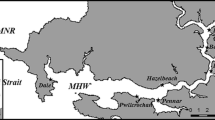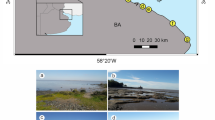Abstract
On the west coast of British Columbia (BC), Canada, the intertidal regions are under ever increasing pressure to be used primarily for near-bottom mariculture practices. These include seeding the foreshore with the nonindigenous Venerupis philippinarum (Manila clam) followed by the application of antipredator netting. The Manila is confamilial with the indigenous Leukoma staminea (littleneck clam), and seeding could possibly provide a competitive advantage for the Manila leading to the extirpation of the littleneck within coastal BC. Over two survey years, nine and seven farm-reference paired beaches (18 and 14 beaches) from three geographically distinct regions of BC were sampled for abundances and size class structure of the Manila and littleneck clam. Several lines of evidence suggest that the Manila is replacing the native littleneck; (1) comparison of average abundances of the littleneck versus Manila showed a significantly greater number of Manila on both farmed and reference sites across all three regions (p < 0.05; years I and II); (2) as distance between farmed and reference sites increased, numbers of littlenecks on reference sites also increased suggesting that close proximity to farmed sites increases the effect of seeding on numbers of the native species; (3) comparison of percent similarity of the population structure as determined by size class distribution for the Manila versus the littleneck clam indicated that intertidal reference sites in close proximity to farmed sites tended to be more similar to each other with respect to similar Manila population structure versus that of the littleneck (r = 0.4; p = 0.08); (4) within the region where active farming is the most aggressive (Baynes Sound), Manila clams are the dominant bivalve on all sampled intertidal regions; and (5) where the dispersal of “wild” (not-seeded) Manila clam is prevented because of thermal tolerance limits, the littleneck is the dominant bivalve. Ecological consequences of such species replacement on intertidal function are as yet known.









Similar content being viewed by others
References
Bendell, L.I., and P. Wan. 2011. Application of aerial photography in combination with GIS for coastal management at small spatial scales: a case study of shellfish aquaculture. Journal of Coastal Conservation 15: 417–431.
Bendell, L.I., C. Duckham, T. L’Esperance, and J.A. Whiteley. 2010. Changes in geochemical foreshore attributes as a consequence of intertidal shellfish aquaculture: a case study. Marine Ecology Progress Series 404: 91–108.
Byers, J.E. 2005. Marine reserves enhance abundance but not competitive impacts of a harvested nonindigenous species. Ecology 86: 487–500.
Chew, K.K. and A.P. Ma. 1987. Species profiles: 1ife histories and environmental requirements of coastal fishes and invertebrates (Pacific Northwest)—common little neck clam. U.S. Fish Wildlife Service Biological Report 82 (11.78). US Army Corps of Engineers, TR EL-82-4. 22 pp.
DFO. 1999. Science Stock Status Report C6-02, 1999. Native Littleneck clam (Protothaca staminea).
Dunham, J.S., B. Koke, G.E. Gillespie, and G. Meyer. 2007. An exploratory survey for littleneck clams (Protothaca staminea) in the Broughton Archipelago, British Columbia—2006. Canadian Manuscript. Canadian Manuscript Report of Fisheries and Aquatic Sciences 2787: 33. viii.
Gillespie, G.E., and N.F. Bourne. 2005. Exploratory intertidal bivalve surveys in British Columbia-2002. Canadian Manuscript Report of Fisheries and Aquatic Sciences 2733: 199. xi +.
Gillespie, G.E., and A.R. Kronlund. 1999. A manual for intertidal clam surveys. Canadian Technical Report of Fisheries and Aquatic Sciences 2270: 144.
Gustafson, R.L., and W.R. Bechtol. 1998. Abundance, recruitment and mortality of Pacific Littleneck clam (Protothaca staminea) at Chugachik Island, Alaska. Journal of Shellfish Research 17: 1003–1008.
Humphreys, J., R.W.G. Caldow, S. McGorty, A.D. West, and A.C. Jensen. 2007. Population dynamics of naturalized Manila clams Ruditapes philippinarum in British Coastal waters. Mar Biol 151: 2255–2270.
Jamieson, G.S., L. Chew, G.E. Gillespie, A. Robinson, L. Bendell-Young, W. Heath, B. Bravender, A. Tompkins, D. Nishimura, and P. Doucette. 2001. Phase 0 review of the environmental impacts of intertidal shellfish aquaculture in Baynes sound. Canadian Science Advisory Secretariat: Ottawa.
Kaiser, M.J., I. Laing, S.D. Utting, and G.M. Burnell. 1998. Environmental impacts of bivalve mariculture. Journal of Shellfish Research 17: 59–66.
Ketchen, S., N. Bourne, and H. Butler. 1983. History and present status of fisheries for marine fishes and invertebrates in the Strait of Georgia, British Columbia. Canadian Journal of Fisheries and Aquatic Sciences 48: 1895–1119.
Krebs, C.J. 1999. Ecological methodology. 2nd edition: Benjamin/Cummings: Menlo Park.
McKinney, M.L., and J.L. Lockwood. 1999. Biotic homogenization: a few winners replacing many losers in the next mass extinction. Trends in Evolution and Ecology 14: 450–453.
Meyer, J.J., and J.E. Byers. 2005. As good as dead? Sublethal predation facilitates lethal predation on an intertidal clam. Ecology Letters 8: 160–166.
Pranovi, F., G. Franceschini, M. Casale, P. Torricelli, and O. Giovanardi. 2006. An ecological imbalance induced by a non-native species: the Manila clam in the Venice Lagoon. Biological Invasions 8: 595–609.
Quayle, D.B., and N. Bourne. 1972. The clam fisheries of British Columbia, 70. Ottawa: Environmental Canada, Fisheries Research Board of Canada.
Shaw, W.N. 1986. Species profiles: life histories and environmental requirements of coastal fishes and invertebrates (Pacific Southwest)—common littleneck clam. United States Fish and Wildlife Service, Biological Report. 82(11.46). U.S. Army Corps o f Engineers, TR EL-82-4. 11 pp.
Whiteley, J.A. 2005. Macrofauna community responses to clam aquaculture practices in British Columbia, Canada. M.Sc. thesis, Simon Fraser University, Burnaby, BC Canada. 134 pp
Acknowledgments
I thank J. Whiteley for statistical assistance on the percent similarity analysis. The technical support of Tracey L’Esperance is greatly appreciated. Field assistance of J. Whiteley, M. Kirk, I. McKeachie, K. Hendersen, D. Leung, N. Martens, V. Sadler, R. Davidson, B. Bartzen, R. Dickson and T. Lewis is gratefully appreciated. Funding for this study was through a National Science and Engineering Research Council (NSERC) Strategic Operating Grant (STPGP246079-01) to LB.
Author information
Authors and Affiliations
Corresponding author
Additional information
Communicated by Marco Bartoli
Rights and permissions
About this article
Cite this article
Bendell, L.I. Evidence for Declines in the Native Leukoma staminea as a Result of the Intentional Introduction of the Non-native Venerupis philippinarum in Coastal British Columbia, Canada. Estuaries and Coasts 37, 369–380 (2014). https://doi.org/10.1007/s12237-013-9677-1
Received:
Revised:
Accepted:
Published:
Issue Date:
DOI: https://doi.org/10.1007/s12237-013-9677-1




